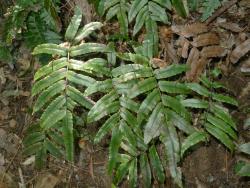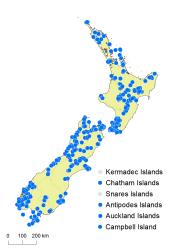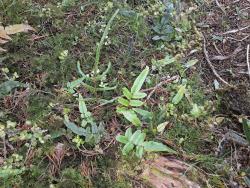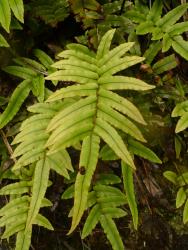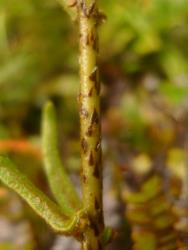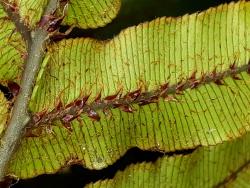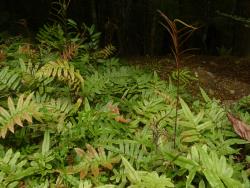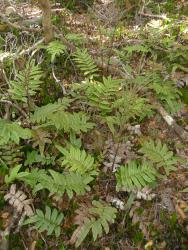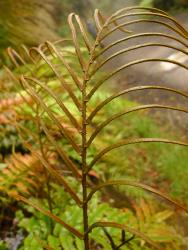- ≡ Osmunda procera G.Forst., Fl. Ins. Austr. 78 (1786)
- ≡ Onoclea procera (G.Forst.) Spreng., J. Bot. (Schrader) 1799(2): 267 (1800)
- ≡ Asplenium procerum (G.Forst.) Bernh., Ueber Asplenium 17, t.1, f.1 (1802)
- ≡ Stegania procera (G.Forst.) R.Br., Prodr. Fl. Nov. Holland. 153 (1810)
- ≡ Lomaria procera (G.Forst.) Spreng., Syst. Veg., ed. 16, 4, 65 (1827)
- ≡ Blechnopteris procera (G.Forst.) Trevis., Atti Reale Ist. Veneto Sci. Lett. Arti II, 2: 166 (1851)
- ≡ Parablechnum procerum (G.Forst.) C.Presl, Epimel. Bot. 109 (1851)
- ≡ Lomaria procera var. α Hook.f., Bot. Antarct. Voy. II (Fl. Nov.-Zel.) Part II, 27 (1855)
- ≡ Blechnum capense var. hookerianum Domin, Biblioth. Bot. 20(85): 115 (1913)
- = Lomaria latifolia Colenso, Tasmanian J. Nat. Sci. 2: 175 (1845)
- = Lomaria duplicata Potts, Trans. & Proc. New Zealand Inst. 9: 491 (1877)
Rhizomes short- to long-creeping, up to 320 mm long (in herbarium material), bearing scales. Rhizome scales ovate to narrowly ovate, 3–11 mm long, 1–2.7 mm wide, uniformly chestnut-brown, or bicolorous with paler margins. Fronds strongly dimorphic; sterile fronds 70–1000 mm long, rarely up to 1400 mm long, prostrate or semi-erect; fertile fronds on same plant longer, 125–1140, or rarely up to 1430 mm long, positioned centrally, held erect. Sterile fronds. Stipes 15–580 mm long, rarely to 830 mm long, black-brown proximally, yellow-brown distally, bearing shiny scales, either uniformly chestnut-brown, or dark brown with paler margins. Rachises yellow-brown, grooved adaxially, scaly. Laminae 45–570 mm long, 20–280 mm wide, 1-pinnate, elliptic or oblong, with an undivided apical segment, dull green or bronze-green, similar colour on both surfaces, sometimes red-tinged when young, coriaceous; scales on abaxial pinna costae dark brown with paler margins, lacking a clearly defined dark spot, sometimes becoming chestnut-brown and concolorous towards the pinna apices. Pinnae in 1–12 pairs, widely spaced, oblong, straight, not or scarcely reduced at the lamina base; the longest pinnae near mid-lamina, 10–195 mm long, 10–35 mm wide, apices acute or obtuse, margins shallowly crenate, bases truncate or rounded, short-stalked; the basal pinnae opposite. Veins free. Fertile fronds. Stipes 85–860 mm long, rarely only 50 mm long or up to 1040 mm long. Laminae 90–440 mm long, 20–230 mm wide. Pinna segments in 2–14 pairs, linear, straight, 18–170 mm long, 2–6 mm wide, not reduced at the lamina base. Sori and indusia in one row either side of the costa, continuous along the length of the pinna.
Note: The unusually large dimensions given here are from plants growing on the Chatham Islands.
Blechnum procerum is recognised by its dimorphic fronds, free veins, stalked sterile pinnae, and continuous sori. The sterile laminae are elliptic to ovate, divided into straight pinnae with obtuse to acute apices and short-stalked bases. The basal pinnae are opposite, and usually not reduced much in size. The laminae bear dark bicolorous scales with pale margins, which occur on the rachises and abaxial pinna costae, sometimes becoming chestnut-brown and concolorous towards the pinna apices. The bicolorous scales have ill-defined dark areas and pale margins, but lack an obvious dark spot. Both lamina surfaces are similar in colour, and the fertile fronds are longer than the sterile.
Blechnum procerum is similar to four other closely related species with stalked sterile pinnae. It is distinguished by its basal pinnae, which are usually scarcely reduced in size, unlike those in B. minus and B. novae-zelandiae, which are many times shorter at the base than at mid-lamina. The basal fertile pinnae in B. procerum are also scarcely reduced in size and do not have basal sterile flanges. The sterile pinnae are straight, have obtuse or acute apices, and are arranged in 1–12 pairs, unlike those in B. triangularifolium, which are falcate, taper to long caudate apices, and are arranged in 6–32 pairs. B. procerum is most similar to B. montanum but is distinguished by its smaller number of sterile pinna pairs (1–12, cf. 5–27), and sterile pinnae, which are broader (10–35 mm wide, cf. 17–24 mm wide), straight rather than falcate, and have obtuse or acute rather than acuminate apices. The fertile fronds are usually much longer than the sterile fronds, whereas in B. montanum they are about equal in length. B. procerum can also be distinguished from B. montanum and B. triangularifolium by its scales with ill-defined dark areas and pale margins, unlike the other two species, which have scales with clearly defined dark spots.
North Island: Northland, Auckland, Volcanic Plateau, Gisborne, Taranaki, Southern North Island.
South Island: Western Nelson, Sounds-Nelson, Marlborough, Westland, Canterbury, Otago, Southland, Fiordland.
Chatham Islands, Stewart Island, Antipodes Islands, Auckland Islands, Campbell Island.
Altitudinal range: 10–1375 m.
Blechnum procerum occurs in lowland to montane areas throughout most of the North Island from Te Paki to Wellington, but is seemingly rare in inland Taranaki and along the east coast. It grows from near sea level up to 1200 m on Mt Ruapehu, but is uncommon below 300 m. It occurs throughout the South Island and Stewart Island, except for the drier parts of inland Otago and south Canterbury. It ranges from near sea level up to 1375 m on Mt Peel, north-west Nelson. It also extends to the Chatham Islands and most of the subantarctic islands.
Blechnum procerum is a terrestrial fern found in open kauri, podocarp, broadleaved and beech forest, under mānuka and kānuka, in scrub, among Phormium, under introduced conifers, and in subalpine scrub and tussock grassland. It grows on the forest floor, on streambanks, in gullies, along tracksides, at forest margins, in open rocky areas, on roadside banks and cuttings, in ditches, on swampy ground, on pākihi soils, and in rough pasture.
There is good evidence for hybridisation between tetraploid Blechnum procerum and diploid B. novae-zelandiae, triploid hybrids with 2n = 112 having been recorded by Chambers & Farrant (1998). Spores in hybrid plants are aborted. Hybrids between B. procerum and B. montanum (e.g. AK 174551, Tangihua Forest, Northland) have also been reported by Chambers & Farrant (1998). Blechnum procerum may also occasionally hybridise with B. minus (e.g. WELT P029462, Charming Creek, Western Nelson).
2n = 112 (Chambers 1954 – as B. minor; Chambers & Farrant 1998).
This species was misidentified as Blechnum minus (R.Br.) Ettingsh. by both Allan (1961) and Crookes (1963).
Chambers & Farrant (1998) selected K 001092705 as the lectotype of Osmunda procera G.Forst. without any reference to the earlier designation by Tindale (1960). This is contrary to Art. 9.19, which states that the author who first designates a lectotype in conformity with Art. 9.11–9.13 must be followed.
Chambers & Farrant (1998) cited a specimen collected by Potts from the Malvern Hills (K 001092715) as the holotype of Lomaria duplicata Potts. However, there is also a specimen in the Armstrong Herbarium (CHR 633349) collected by Potts from the Malvern Hills, which appears to be a duplicate, and which was not seen by Chambers & Farrant. Their citation of the specimen in K is therefore an inadvertent lectotypification.
Domin (1913) used the name Blechnum capense var. hookerianum for the plant listed as Lomaria procera var. α by Hooker (1854–1855), although Domin erroneously cited it as “Lomaria capensis var. α”. Hooker’s var. α would have been the variety that included the type of Forster’s original species, Osmunda procera, and hence Domin’s Blechnum capense var. hookerianum is listed here as a homotypic synonym. Chambers & Farrant (1998) also included Hooker’s var. α as a synonym of Blechnum procerum.
Domin (1913) used the name Blechnum capense var. contractum for the plant listed as Lomaria procera var. γ by Hooker (1854–1855). Chambers & Farrant (1998) included Hooker’s var. γ in the synonymy of Blechnum procerum, and that is where this name probably belongs. However, no original material was cited, and none has been located in either Hooker’s herbarium at K, or in Domin’s herbarium at PR. Hence the true identity of the name remains uncertain.



